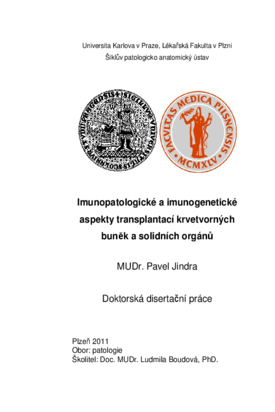Imunopatologické a imunogenetické aspekty transplantací krvetvorných buněk a solidních orgánů
Immunopathological and immunogenetic aspects of haematopietic stem cell and solid organ transplantations
dissertation thesis (DEFENDED)

View/
Permanent link
http://hdl.handle.net/20.500.11956/35235Identifiers
Study Information System: 105920
CU Caralogue: 990013691820106986
Collections
- Kvalifikační práce [341]
Author
Advisor
Referee
Fakan, František
Slavčev, Antonij
Faculty / Institute
Faculty of Medicine in Pilsen
Discipline
-
Department
Information is unavailable
Date of defense
21. 6. 2011
Publisher
Univerzita Karlova, Lékařská fakulta v PlzniLanguage
Czech
Grade
Pass
KIR geny a jejich produkty- killer imunoglobulin-like receptory (KIR) na povrchu NK buněk (natural killers) jsou jedním z klíčových prvků vrozené imunity člověka. NK buňky jsou to rychle účinkující efektorové buňky, které primárně likvidují virem infikované a nádorové buňky Tato schopnost destruovat cílové buňky je dána vzájemnou interakcí mezi KIR receptory a příslušnou specifickou HLA molekulou na povrchu buněk, neboli ligandem KIR receptorů. Genetická diverzita KIR genů a genotypů připomíná diverzitu HLA systému. Přestože jsou geny kódující KIR a HLA lokalizované na různých chromozomech a segregují se tedy nezávisle, existují určité důkazy alespoň částečné koevoluce obou systémů. Lze tudíž předpokládat. U HLA restrihované populace lze tedy očekávat alespoň částečnou redukci v diverzitě KIR genů i genotypů. Celkem 41jedinců homozygotních v ancestrálníml HLA haplotypu AH8.1 (HLA-A*0101-Cw*0701-B*0801-DRB1*0301-DQB1*0201), bylo kompletně genotypizováno pro KIR geny. Celkově bylo zjištěno celkem 14 různých KIR genotypů, přičemž zaznamenaná frekvence výskytu KIR genů a kompozice KIR genotypů v podstatě odpovídala datům ze studií u neselektované (ve smyslu HLA) populace Kavkazanů ("Caucasians"). Takzvané "non-framework" KIR geny s frekvencí více než 90 % zahrnovaly KIR2DL1, KIR2DL3, KIR3DL1, KIR2DS4 a KIR2DP1....
The genetic diversity of KIR genes and genotypes resembles of the HLA. Although the genes encoding KIR and HLA are located in different chromosomes and segregate independently, there is some evidence of some kind of co-evolution. Therefore, one could expect reduced KIR diversity within the HLA restricted population. A total of 41 unrelated individuals homozygous for ancestral HLA haplotype AH8.1 (HLA-A*0101-Cw*0701-B*0801- DRB1*0301-DQB1*0201), were typed for KIR genes. Over all, fourteen different genotypes were identified. The observed frequencies of KIR genes and genotypes composition generally mirror the published frequencies in Caucasians. Non-framework genes with frequency of more than 90 % included KIR2DL1, KIR2DL3, KIR3DL1, KIR2DS4 and KIR2DP1. Except for the KIR2DS4, all activating genes presented frequencies bellow 50 %. KIR2DS5 was the least frequent among activating genes (17 %), whereas KIR2DL5 (37 %) among inhibitory ones. The most frequent (39 %) was AA genotype. 22 individuals (54 %) had a copy of KIR haplotype A and B (AB genotype), whereas 3 (7%) were homozygous for B (BB genotype). Nine of 14 reported genotypes occurred only in one individual. Comparing with published and recorded genotypes (www.allelefrequencies.net), 5 genotypes were reported in less than 20 individuals worldwide and...
